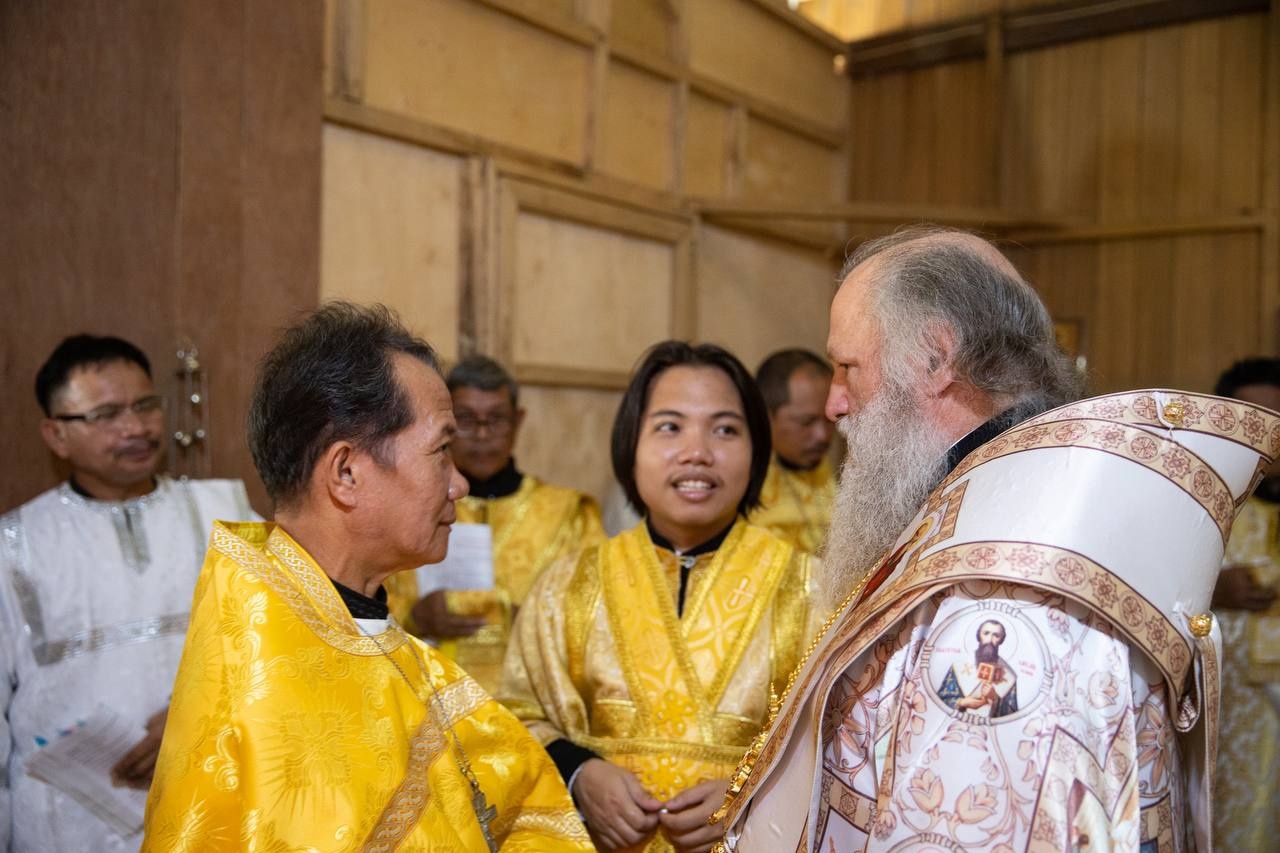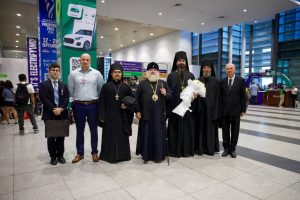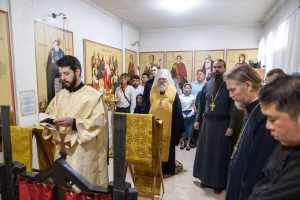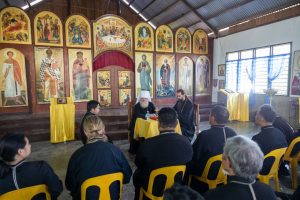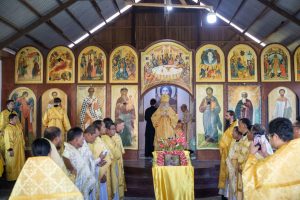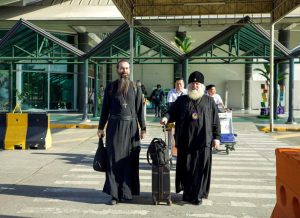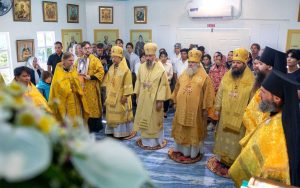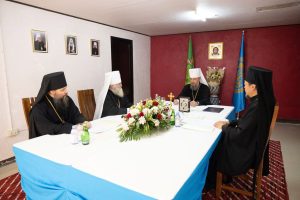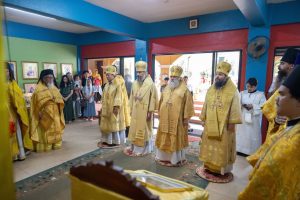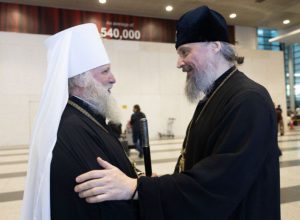In the town of Kinabalan, on the Philippine island of Mindanao, an Orthodox church is being built in honor of the Apostle Thomas. Hieromonk Korniliy, secretary of the Philippine-Vietnamese Diocese, told us about the construction of the temple and about Orthodoxy on the island. He has been helping the locals to get closer to the Lord for the fifth year.

In 2020, Metropolitan Pavel of Manila and Hanoi, the administrator of the Philippine-Vietnamese Diocese (and Metropolitan of Khanty-Mansi and Surgut) blessed the cross and the foundation stone at the construction site of the temple in Kinabalan. But because of the pandemic, it was only in 2021 that the site was prepared and the piles were hammered.For Russian scale, the temple is small. Its area is only 220 square meters. But for the island of Mindanao, and even more so for the settlement of Kinabalan, this is a palace. The houses here are made of bamboo, and the temple that used to stand on this place also looked more like a hut made of stone and bamboo with an earthen floor.– The Philippines is a very poor country, many people are starving here, and they don’t have money for building materials. They are happy to work on the construction of the temple, but the engineering solution, of course, is ours,” says Hieromonk Korniliy. – That’s why we announced a raising of donations for its construction in Russia, and many Yugra residents responded. Thanks to the funds collected this year, the foundation of the temple was completed and the erection of columns began.The island country is constantly experiencing earthquakes and typhoons. The project of the temple was developed by the architectural department of the Khanty-Mansi Metropolia specifically for the Philippines. The stone church must withstand an earthquake with a magnitude of 9 points.There are frequent and prolonged rains in Mindanao. Protection from rain sometimes becomes a real problem. If there is a metal roof in the church, then the rain is drumming on it so hard that nothing can be heard during the service.The new temple will have one dome with a tent. It will be made on the spot from a special dome metal, which will be brought from Russia. Another feature of Filipino Orthodox churches is the absence of a bell tower.”There is no bell ringing culture here,” the priest explains. – Filipinos do not know how to cast bells or ring. It is problematic to deliver a bell from Russia, and you can’t hang it on a bamboo structure. Instead of a bell, a cut-off gas cylinder is used here, which is beaten with a hammer when people are called to service. Now there are about 200 people in the community. Priest Joakim Gonzalez will serve in the new church in honor of the Apostle Thomas, and when Filipino seminarians return with diplomas from the St. Petersburg Academy, then, God willing, there will be a permanent priest in the church.
Father Joakim
Father Joakim has a very interesting story. He was an Aglipai priest, there were five parishes under him. The Aglipayans are followers of Gregorio Aglipay, who separated from the Roman Catholic Church and founded an “Independent Filipino church” about 120 years ago, as a result of the war for independence from Spain. Now this church, covering about two million people, has been divided into almost one hundred “more” independent “churches”.
– Priest Joakim began to search for the truth with his parishioners a long time ago and found him in Orthodoxy, abandoning his Aglipai priesthood. But, unfortunately, instead of a real Orthodox church, he, without knowing it, first got to the schismatics. And only after a few years, having figured it out, he turned to the Russian Orthodox Church. And for the second time he lost his schismatic “priesthood” for the sake of staying in the true church. So he was accepted as an ordinary layman with all his five parishes, and after a long training he was ordained to the rank of a real Orthodox priest,” explains Hieromonk Korniliy.
He emphasizes that 9 years ago, Filipinos themselves appealed to the Russian Orthodox Church with a request for their admission to the ROC. There were 2 bishops, 10 priests and 28 parishes located on the island of Mindanao uniting several thousand people. They were baptized right in the ocean. According to Father Korniliy, even now the Kinabalans are undergoing the rite of baptism in groups in the river or ocean.
In general, among the Filipinos there are also pagans, Muslims, Catholics and various sectarians

Our daily bread
The history of Christianity in the Philippines began in the XVI century, when the Spaniards reached the coast of the country. Catholic Christianization of the population was carried out by various monastic orders.
– Services are held in the local language of Cebuano. Catholics even under Magellan translated the Bible into Cebuano, and nothing more. During several years of our mission, we have translated a lot of literature on worship and catechesis. But there are still problems. We have been watching the services since childhood. And local priests do not have such experience, and it is necessary to explain to them, and it is better to show them how and what is done during the service, but there are so few of us here,” Father Korniliy complains.
The hieromonk told about the case of the translation of the prayer “Our Father” in Cebuano:
– Our daily bread is our main food, food in principle, the sustenance necessary for life. For Filipinos, bread (tinapai) is an optional sweet snack to drink with coffee. Their main food is rice. The words “rice” – “pagkaon”, and “food” – “pagka-on” are almost similar. So we did not translate “give us an optional snack for this day”, we translated “pagka-on”
Russians and miracles
Filipinos do not know how to light a candle or how to worship an icon, and representatives of the Russian Orthodox Church teach them. They also teach how to bake cakes and paint eggs for Easter. Local Orthodox People like this tradition very much, as well as body crosses. They also believe in miracles.Since 1949, when 6 thousand Russian “white emigrants” who fled from China landed on the deserted shore of Tubabao Island, Filipinos have been watching how the Lord helps the Orthodox.The refugees came to Tubabao with St. John of Shanghai. They thought they would stay here for a few months, but they lived for three years. They lived in a tent camp. The refugees opened two schools and 3 Orthodox churches. During this time, not a single typhoon hit them – it’s a miracle. After all, several typhoons come from the ocean every year. Filipinos say that typhoons were calmed through the prayers of St. John.– In general, in the Philippines, God’s help is felt all the time. In 2022, we quite miraculously acquired land on the site where the Russian refugees with St John of Shanghai lived. Half of the land was donated to us by a Catholic grandmother, half was sold at a big discount with the help of the mayor’s office, which also treated us well. And the sponsor was found unexpectedly. We bought even more than we had planned. Every step of this process was a miracle through the prayers of the wonderworker John,” Hieromonk Korniliy affirms.By the way, it is God’s will that it was Metropolitan Pavel of Khanty-Mansiysk and Surgut who became the administrator of the Philippine-Vietnamese diocese. He had served in San Francisco, just where the relics of St. John of Shanghai rest.


